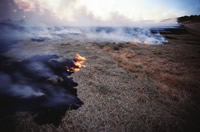The exercise program meets the Oil Pollution Act of 1990 (OPA) mandate for exercises and represents minimum guidelines for ensuring overall preparedness within the response community. This is industry’s opportunity for continuous improvement of the response plans and the response system.
Who developed the PREP Guidelines?
PREP was developed as a coordinated effort of the four federal agencies with responsibility for pollution response preparedness—the U.S. Coast Guard, EPA, Department of Transportation, and the Department of Interior’s Minerals Management Service (MMS).
The agencies worked with federal, state, and local governments, the oil and marine transportation industry, cleanup contractors, and the general public to develop the program. PREP meets the intent of OPA recognizing the economic and operational constraints of those affected by the exercise requirements.
To solicit input from all parties involved, a series of public workshops were held that resulted in the PREP Guidelines. The Guidelines outline an exercise program that satisfies the exercise requirements of the four federal regulatory agencies.
Who participates in PREP?
PREP is a voluntary program. Participation in PREP will satisfy the exercise requirements of the Coast Guard, EPA, DOT, and MMS and, therefore, is applicable to their regulated communities. If an FRP Plan holder does not choose to follow the PREP Guidelines, the Plan holder must meet the exercise requirements mandated by the federal agency with regulatory oversight for the specific type of industry.
EPA’s SPCC regulation affects over 630,000 companies. Is yours one? Download your EHS Essentials Kit—SPCC Plan Compliance now for all the tools you need to be in compliance. Download Now
What are internal exercises?
Internal exercises are held wholly within the Plan holder’s organization. The exercises do not usually involve other members of the response community but are designed to examine the adequacy of various components of the response plan. All internal exercises should be self-evaluated and self-certified. The internal exercises include:
- Qualified Individual notification
- Emergency procedures for vessels and barges
- Emergency procedures for facilities (optional)
- Spill management team tabletop exercises
- Equipment deployment exercises
- Unannounced exercises (not a separate exercise)
Every 3 years all components of the entire response plan must be exercised. It is not necessary to exercise them at the same time, and therefore, PREP allows the flexibility to exercise different components over a triennial period. The Plan holder is responsible for documenting the components completed in the exercises.
What is an external exercise?
External exercises involve the Plan holder and other members of the response community. They are used to evaluate the response plan and the Plan holder’s ability to coordinate with the response community to conduct an effective response to a pollution incident. The external exercises include:
- Government-Initiated Unannounced Exercise
- Area exercise
Don’t risk an EPA fine! Stay in compliance with our EHS Essentials Kit—SPCC Plan Compliance. Download now for instant access to comprehensive checklists, common violations, training materials, forms, and more. Download Now
What is an area exercise?
An area exercise is designed to exercise the government and industry interface for pollution response. An area is defined as “that geographic area for which a separate and distinct Area Contingency Plan has been prepared, as described in OPA 90.” The goal of PREP is to conduct 18 area exercises per year—6 government-led and 12 industry-led exercises. A team comprised of representatives from federal, state, and local governments, and industry designs the exercise.
The “lead plan holder” leads the area exercise. The exercise design should be done as a cooperative effort; however, the lead Plan holder has the primary voice and final decision authority in the exercise design. In the case of the six government-led exercises, either the Coast Guard or EPA is the lead Plan holder. An industry Plan holder who participates in an area exercise would not be required to participate in another exercise for a minimum of 6 years. Plan holders are responsible for funding their participation in the area exercise.
What is involved in an area exercise?
An area exercise does not have to be, nor is it expected to be, a big production. They should be approximately 8–12 hours long and involve some amount of equipment deployment. The extent of equipment deployment should be determined by the lead Plan holder, in consultation with the exercise design team.

